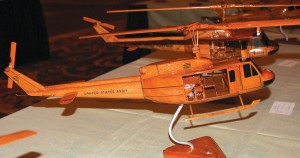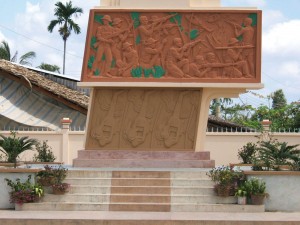
The logo of the Vietnam Helicopter Pilots Association was proudly displayed in Phoenix during the group’s 24th annual reunion.
By Bob Shane
Phoenix was the 2007 landing zone for the 24th annual reunion of the Vietnam Helicopter Pilots Association. From July 3-7, it was the place to hear great war stories. More than 1,100 people braved the Arizona summer heat to attend the event.
Founded in 1984 by Larry Clark, VHPA has more than 40,000 names in its database, of which more than 13,000 are members. The first reunion, held in Phoenix in 1984, attracted 66 pilots who flew in Vietnam.
“My goal in starting VHPA was to bring people together,” Clark said. “It’s very satisfying for me to see friends come together, who haven’t seen each other since completing their war service.”
While it wasn’t a stated objective of the group, over the years, Clark has seen the image of the Vietnam vet evolving into something more positive.
The one symbol, perhaps more than any other, that epitomizes the Vietnam War is the UH-1 Huey helicopter, not only because of the visual imagery, but also because of the chopper’s distinctive sound. Just thinking about that historic conflict conjures up images of a flight of assault Hueys, transiting the sky in V formation, ultimately landing in a rice paddy to unload soldiers going into battle. Whether it’s a “Slick” (troop transport) or a “Gunship,” hardly a war story was told during the reunion that didn’t include the UH-1 helicopter. The Huey was the backbone of U.S. activities in Southeast Asia.
While storytelling can be an art, the stories told at the JW Marriott Desert Ridge Resort & Spa during the “War Story Contest” were more from the heart than an art form.
“I’m not a public speaker,” one helicopter pilot asserted. “I’d rather be bitten by a rattlesnake than do this.” With that admission out of the way, he shared his personal war experiences with those present.
The majority of the stories were absolute tearjerkers, both for the speakers and for the listeners. The pilots speaking would often choke up with emotion. However, they had lighter moments, like when a chopper driver described flying his helicopter underneath a bridge with only 10-foot clearance above and below his aircraft. Or when a Huey pilot said that he had found a UH-1B operator’s manual on eBay.

Professional artist Joe Kline was available during the reunion to paint limited edition prints for any pilot wanting a custom representation of the helicopter he flew in Vietnam.
“I never read one,” he added.
One of the more poignant combat stories was that of Chief Warrant Officer Ron Cone of Modesto, Calif. Cone was a participant in “The Battle of Easter Sunday.”
It was March 26, 1967, Easter Sunday. For Cone, a helicopter pilot stationed at an airbase in the Mekong Delta, this was supposed to be a down day—a chance to catch up on some sleep. But an alarm sounded, and he found himself in a scramble to get his helicopter airborne. His Huey was part of a flight of 10, transporting an estimated 120 South Vietnamese troops and their American advisors to engage a large enemy force of Viet Cong.
Cone’s helicopter was positioned in the “golden two” position, to the right of the lead aircraft. As the choppers started setting down in a rice paddy, all hell broke loose. The air above the landing zone suddenly became alive, saturated with a hailstorm of bullets. While being under fire wasn’t unusual, this was the most intense fire Cone had ever experienced. Using a tree line along the edge of the rice paddy for cover, the VC opened up with machine guns, mortars and recoilless rifles.

Event guests had the opportunity to order hand-carved mahogany models of every type helicopter flown during the Vietnam War, personalized with unit insignias and tail numbers. The models are made in Vietnam.
“Outlaw 17,” a Huey piloted by Cone’s good friend Jon Myhre, was shot down over the LZ. A medevac helicopter sent in to pick up Myhre and his crew was also shot down. The battle lasted 12, with more than 100 jet and prop aircraft involved in the engagement.
Of the 30 helicopters that ultimately participated, three were shot down in the LZ with a fourth downed while returning to its base. The list of casualties included four Americans killed and 12 wounded; 42 South Vietnamese soldiers were killed and 69 were wounded. The VC body count of 142 was little consolation for those who lost good friends that day.
Miraculously, Cone’s helicopter didn’t take a single hit. On March 26, he wrote in his diary that Jon Myhre “didn’t make it.” However, the following day, good news was announced; Myhre had been reported dead but was found alive in the LZ and was going to make it. Some say he “rose from the dead on Easter Sunday.

Helicopter pilot Ron Cone took part in the fierce Vietnam War battle that became known as “The Battle of Easter Sunday.”
Forty years after that fierce battle in a rice paddy, Cone felt compelled to return to the country he viewed as beautiful; he wanted to experience Vietnam without the distraction of war. The visit would be an opportunity to resolve unanswered questions, honor the memory of fallen comrades and complete an important chapter in his life.
This past spring, Cone and five other Easter battle survivors traveled to Vietnam. Cone didn’t know what to expect and didn’t even know if they’d be able to find the battle site. And for the experience to be the most meaningful, it was important that they be at the site on the anniversary date.
With the help of the local Vietnamese, the men located the battle site on March 26, in a rural area near the village of Hoa Binh. Much to their amazement, the group discovered a compound surrounded by a seven-foot wall. Inside was a beautiful 35-foot high monument, built by their former enemy, commemorating the Battle of Easter Sunday. Around the monument were pictures in bas-relief, depicting the conflict; three American helicopters were shown falling to the ground in flames, and another showed the Viet Cong transporting their wounded soldiers away in flat-bottomed wooden boats called sampans. A plaque described the battle as a heroic victory for the Viet Cong, with 600 American and allied troops killed.

On March 26, Ron Cone and five comrades returned to Vietnam to visit the site of “The Battle of Easter Sunday.” They discovered that the Vietnamese had built a beautiful, 35-foot monument on the site of the battle, which had taken place on that very day,
After the passage of 40 years, Cone harbors no ill will towards his former enemy. During his visit to Vietnam, he says he felt welcome and believes that the Vietnamese enjoy having Americans visit their country.
“I went back in celebration of my life,” he said. “”Seeing the monument commemorating the battle was an acknowledgement we were there.”
Cone’s now ready to close that chapter of his life.
“My Vietnam experience is more complete, and I’m more satisfied with who I am after this experience,” he said.

Clearly depicted on the Vietnamese-built monument to commemorate “The Battle of Easter Sunday” were three American helicopters falling to the ground in flames and the Viet Cong soldiers who shot them down.












